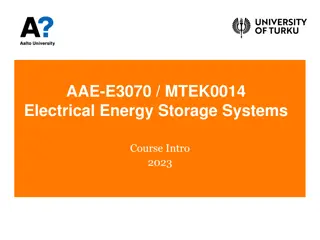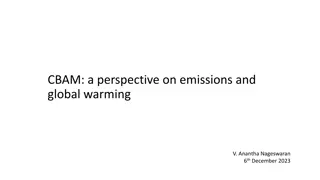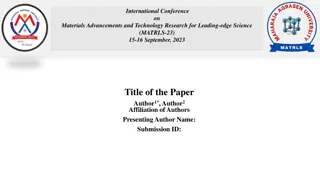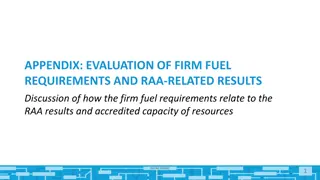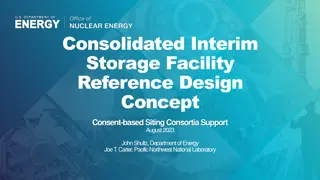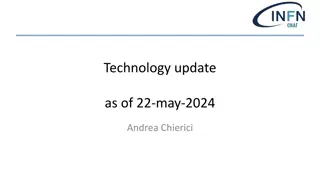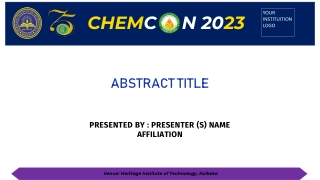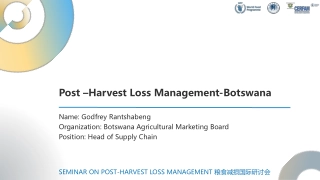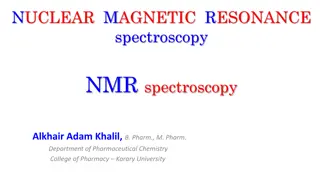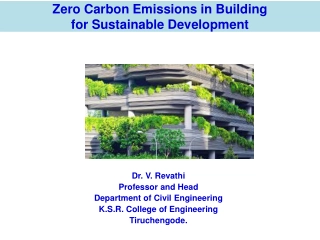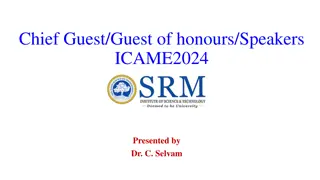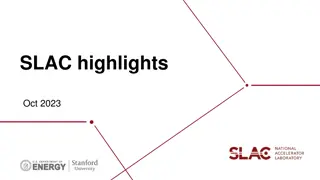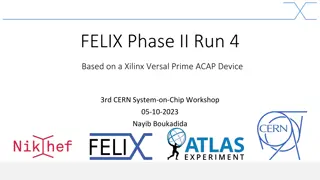
What are the Latest Advancements in Carbon Capture and Storage Technology
As the global community grapples with the escalating impacts of climate change, the urgency to reduce carbon dioxide (CO2) emissions has never been greater. One of the most promising solutions to mitigate climate change is Carbon Capture and Storage (CCS) technology. CCS involves capturing CO2 emissions from industrial sources and power plants and storing them underground to prevent them from entering the atmosphere. This blog explores the latest advancements in CCS technology, highlighting how companies like Vinz Global drive innovation to support climate and sustainability goals.
Download Presentation
Please find below an Image/Link to download the presentation.
The content on the website is provided AS IS for your information and personal use only. It may not be sold, licensed, or shared on other websites without obtaining consent from the author. Download presentation by click this link. If you encounter any issues during the download, it is possible that the publisher has removed the file from their server.
Presentation Transcript
What are the Latest Advancements in Carbon Capture and Storage Technology? As the global community grapples with the escalating impacts of climate change, the urgency to reduce carbon dioxide (CO2) emissions has never been greater. One of the most promising solutions to mitigate climate change is Carbon Capture and Storage (CCS) technology. CCS involves capturing CO2 emissions from industrial sources and power plants and storing them underground to prevent them from entering the atmosphere. This blog explores the latest advancements in CCS technology, highlighting how companies like Vinz Global drive innovation to support climate and sustainability goals. The Importance of Carbon Capture and Storage Before diving into the latest advancements, it's crucial to understand why CCS is so vital for climate and sustainability. The primary objective of CCS is to reduce CO2 emissions significantly, the leading cause of global warming. By capturing and storing carbon emissions, CCS can help: 1.Mitigate Climate Change: By preventing CO2 from entering the atmosphere, CCS directly addresses the root cause of global warming. 2.Support Sustainable Development: CCS can enable the continued use of fossil fuels in a more environmentally friendly manner while renewable energy sources scale up.
3.Enhance Energy Security: CCS can make existing energy infrastructure more sustainable, providing a bridge to a low-carbon future. Latest Advancements in Carbon Capture Technology 1.Advanced Solvent-Based Capture Systems Traditional CCS systems have relied on chemical solvents to absorb CO2 from flue gases. Recent advancements have focused on developing more efficient and cost-effective solvents. These new solvents have higher CO2 absorption capacities, faster reaction rates, and lower energy requirements for regeneration. Vinz Global has been at the forefront of this innovation, working on proprietary solvent formulations that enhance capture efficiency and reduce operational costs. 1.Solid Sorbent Technologies Solid sorbent technologies are emerging as a viable alternative to liquid solvents. These materials, such as metal-organic frameworks (MOFs) and zeolites, can selectively adsorb CO2 from gas streams. Solid sorbents offer several advantages, including lower energy consumption for regeneration and reduced corrosion issues. Recent breakthroughs have developed high-capacity sorbents with rapid adsorption/desorption cycles, making them suitable for large-scale applications. 1.Membrane-Based Capture Systems Membrane technology is another exciting area of development in CCS. These systems use selective membranes to separate CO2 from other gases. Innovations in membrane materials and configurations have significantly improved their efficiency and durability. Vinz Global is
investing in advanced membrane technologies that promise to reduce the cost and complexity of CO2 capture, making it more accessible for various industries. 1.Direct Air Capture (DAC) Direct Air Capture involves extracting CO2 directly from the ambient air. This approach is particularly promising for achieving harmful emissions, as it can remove existing CO2 from the atmosphere. Recent advancements in DAC technology have led to the creation of more efficient and scalable systems. Companies are developing modular DAC units that can be deployed in various locations, from industrial sites to urban environments. These units use less energy and capture more CO2 than earlier models, paving the way for widespread adoption. Latest Advancements in Carbon Storage Technology 1.Improved Geological Storage Techniques Geological storage involves injecting captured CO2 into underground rock formations, such as depleted oil and gas fields or deep saline aquifers. Advances in this area have focused on enhancing the security and capacity of storage sites. Enhanced oil recovery (EOR) techniques, for instance, utilize CO2 to extract additional oil from reservoirs, simultaneously storing the CO2 underground. New monitoring and verification technologies ensure the long- term stability and safety of stored CO2, addressing concerns about potential leakage. 1.Mineralization Mineralization is when CO2 reacts with naturally occurring minerals to form stable carbonates, effectively locking away the CO2 permanently. Recent research has made significant strides in accelerating the mineralization process, making it a viable storage
option. Innovations include engineered minerals that react more quickly with CO2 and techniques to enhance the contact between CO2 and reactive minerals. Vinz Global is exploring partnerships to develop commercial-scale mineralization projects that can contribute to permanent carbon sequestration. 1.Bioenergy with Carbon Capture and Storage (BECCS) BECCS combines bioenergy production with CCS, capturing CO2 from biomass energy processes. This approach can result in harmful emissions, as plants absorb CO2 during growth, which is then captured and stored during energy production. Advances in BECCS technology have improved the efficiency of both the biomass conversion and carbon capture processes. This dual benefit of energy production and carbon removal makes BECCS a critical component of comprehensive climate strategies. 1.Innovative Storage Solutions In addition to traditional storage methods, innovative approaches are being explored to enhance carbon sequestration. These include: Carbon Utilization: Converting captured CO2 into valuable products, such as building materials, fuels, and chemicals. This not only stores CO2 but also creates economic value. Ocean Storage: Investigating ways to store CO2 in the deep ocean safely. While this method is still experimental, it holds potential for large-scale sequestration. Vinz Global's Role in Advancing CCS Technology
Vinz Global is a leading player in developing and deploying advanced CCS technologies. The company is committed to supporting climate and sustainability goals through innovative solutions that make CCS more efficient, cost-effective, and scalable. Some of Vinz Global s key initiatives include: Research and Development: Investing heavily in R&D to develop next-generation capture and storage technologies. This includes collaborations with academic institutions, government agencies, and industry partners. Pilot Projects: Implementing pilot projects to test and demonstrate the viability of new CCS technologies. These projects provide valuable data and insights that guide further development and commercialization. Sustainability Integration: Ensuring that all CCS initiatives align with broader sustainability goals. This includes minimizing the environmental impact of CCS operations and maximizing their contribution to reducing global CO2 levels. The Future of Carbon Capture and Storage The advancements in CCS technology are crucial for achieving global climate and sustainability targets. As innovation continues, the cost and efficiency of CCS are expected to improve, making it an integral part of the worldwide strategy to combat climate change. Companies like Vinz Global are leading the charge, demonstrating that it is possible to significantly reduce CO2 emissions and build a sustainable future with the suitable investments and commitment.
Conclusion Carbon Capture and Storage technology is at the forefront of efforts to address climate change and promote sustainability. The latest advancements in CCS, from advanced solvent systems and solid sorbents to direct air capture and innovative storage solutions, make it more feasible and practical. Companies like Vinz Global are driving these innovations, ensuring that CCS technology plays a pivotal role in our transition to a low-carbon economy. By continuing to invest in and develop CCS technologies, we can make significant strides towards a sustainable future where CO2 emissions are dramatically reduced and climate goals are met. Content Courtesy url - https://medium.com/@vinzglobal.social/future-proof-your-business- enterpriseapplication-development-strategies-6c0f06e88d6a Contact US Website https://vinzglobal.com/climate-and-sustainability/ Mobile +91 7030090136 Mail- vinz.sales@vinzglobal.com





